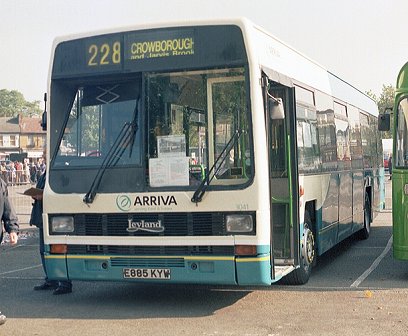
Prepared on Notepad by Ian Smith,
This page created 22nd February 2006.

The Leyland Lynx around London
 The Lynx never was a central London Bus. Yes, there were a few in the Central fleet,
but these worked out at the Uxbridge periphery. But for a bus which had arrived in
a market not prepared to receive it it boasted quite a large number scattered around the
London edges. The Lynx had been designed to follow on from the Leyland National.
Whereas the National had been an integrally-constructed bus, the Lynx had a chassis.
While the National had been built to a one-size fits all philosophy
(until London and London Country forced a down-size),
the Lynx offered the operator's choice of bodybuilder, if not a choice of dimensions.
The National had been forced upon NBC operators (even if they would have preferred to stick with Bristol REs.
The Lynx was originally aimed outwith the NBC, and for the export market,
which had proved stubbornly resistant to the National.
The Lynx never was a central London Bus. Yes, there were a few in the Central fleet,
but these worked out at the Uxbridge periphery. But for a bus which had arrived in
a market not prepared to receive it it boasted quite a large number scattered around the
London edges. The Lynx had been designed to follow on from the Leyland National.
Whereas the National had been an integrally-constructed bus, the Lynx had a chassis.
While the National had been built to a one-size fits all philosophy
(until London and London Country forced a down-size),
the Lynx offered the operator's choice of bodybuilder, if not a choice of dimensions.
The National had been forced upon NBC operators (even if they would have preferred to stick with Bristol REs.
The Lynx was originally aimed outwith the NBC, and for the export market,
which had proved stubbornly resistant to the National.
Arriva Kent & Sussex 3041 turned up at the Gravesend Classic Coach Running Day in October 2005.
This had started with Grey-Green in 1987,
spending nine years with them before moving to Arriva Kent & Sussex for a similar period.
But its timing was appalling. The National Bus Company fleets had filled up with Nationals,
which were proving robust and very long-lived (even if they consumed engines, oil and fuel at alarming rates).
One man operation had been approved for double-deckers, which instantly reduced the market for large single-deckers.
The uncertainties engendered by tendering in London and deregulation in the rest of the country
were making fleet managers look very carefully at their capital commitments,
and caused a rash of midibus fleets, which offered short-term cheap solutions to match the
cheap short-termism of the current politics.
This showed itself in the histories of the Lynxes too, with frequent changes of ownership
as ventures flourished and foundered.
So although the first Lynx appeared in 1985, the order-book was very thin.
Only 25 were registered nationally in 1986, deregulation year. 1987 saw only 60.
But these included the first for the London area,
with a half-dozen going to London Buslines to replace secondhand Daimler Fleetlines
on its tendered routes.
London Buses tried one out on the 70 from Peckham, briefly, before it went for service in Scotland.
Boro'line Maidstone, building up its London operations,
also bought three to supplement its secondhand Nationals on tendered routes.
Kentish Bus and Metrobus both dipped their toes in the pond
by entertaining demonstrators.
Jubilee Buses at Stevenage also had a demonstrator, and bought it,
following on with another six during 1987 and 1988.
Grey-Green also bought a batch for tendered east London work.
Mid-1988 brought eight to Central Area London work, when Atlas Bus bought them to work the 112
between Ealing Broadway and Palmers Green via the North Circular Road.
Metrobus stuck a further toe in the water, buying one for use at Godstone.
London Borough of Hillingdon bought a couple at the end of 1988 for London Buses to operate on the 128.
These were followed in 1989 by a batch for use on the Express 607 along the Uxbridge Road,
six new ones and three secondhand from Merthyr Tydfil.
Three more from Merthyr joined Grey-Green,
and another three went to Metrobus at Orpington.
Bee Line bought some new ones.
Boro'line bought another twelve in autumn 1989 for London work, mainly in the Bexleyheath area.
London and Country bought six at the end of the year to use from Godstone.
Luton & District acquired five in July 1989, and another four in October 1990.
County Bus bought eight in July 1990 for Harlow area operations.
Meanwhile Essex Buses had bought a sizeable batch,
some of which found their way onto London operations via Thamesway.
Blue Triangle bought eight secondhand buses from around the country for its own use,
mainly for the unused emergency evacuation fleet for the London Dome.
All this variety was still not very many buses. And they did not stay put.
The Lynxes had been bought mainly to fill tender niches,
which began to disappear or change. Operators vanished. Routes too. Buses went on the secondhand market
and cropped up elsewhere in London - or not. Buses were transferred in to Sovereign from other Blazefield companies in Yorkshire.
The Bee Line buses moved to Wycombe Bus.
Takeovers were not confined to small companies like Jubilee. Sovereign sold its Stevenage operations (with some Lynxes)
to Luton & District. City of Oxford sold their Wycombe Bus operation to Arriva The Shires.
Thamesway disappeared during a rationalisation. The Lynxes mainly just kept on going,
with whatever owner had their colours painted on the sides. Many survived the Millenium
before being sold on, mainly for further use elsewhere.
Contents

 Ian's Bus Stop Ian's Bus Stop
 LX Contents. LX Contents.
 London BusLines. London BusLines.
 LX photo refs. LX photo refs.
|

